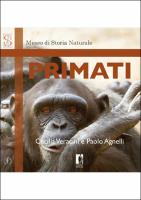Primati
| dc.contributor.author | Veracini, Cecilia | |
| dc.contributor.author | AGNELLI, PAOLO | |
| dc.date.accessioned | 2022-05-31T10:14:30Z | |
| dc.date.available | 2022-05-31T10:14:30Z | |
| dc.date.issued | 2008 | |
| dc.identifier | ONIX_20220531_9788884538871_116 | |
| dc.identifier.uri | https://library.oapen.org/handle/20.500.12657/54832 | |
| dc.language | Italian | |
| dc.subject.other | Antropologia | |
| dc.subject.other | Zoologia | |
| dc.subject.other | Scienze naturali | |
| dc.subject.other | Museo di storia naturale | |
| dc.subject.other | Firenze | |
| dc.subject.other | Specola | |
| dc.title | Primati | |
| dc.type | book | |
| oapen.abstract.otherlanguage | The first descriptions of the anthropomorphic monkeys reached Europe channelled through a combination of legend, anecdote and travel journal. The first actual chimpanzee in flesh and blood only arrived around the seventeenth century, and the similarity between these great apes and human beings immediately unleashed conflicting reactions of attraction and awe, fascination and anxiety. Other primates had already been known in the Western world since antiquity, but creatures so similar to ourselves inevitably set human beings in relation to the rest of the natural world, or rather placed them within the same ongoing process, undermining the attempt at distinction from other animals and the claim to a sovereignty over the planet. We now know that we are not so unique and that we share numerous aspects with our primate cousins. Observing them, respecting them and attempting to understand them is the best way of entering into profound contact with our own nature. | |
| oapen.identifier.doi | 10.36253/978-88-8453-887-1 | |
| oapen.relation.isPublishedBy | bf65d21a-78e5-4ba2-983a-dbfa90962870 | |
| oapen.relation.isbn | 9788884538871 | |
| oapen.relation.isbn | 9788892737778 | |
| oapen.pages | 80 | |
| oapen.place.publication | Firenze |

